
After much pre-planned faffing over the time of the tides and an exceptionally early morning delivery of furniture for the Earl of Pigs Alley, it was a full compliment of nine brave souls who departed for the Gower Peninsula remarkably punctual at the agreed time of 9.30am. Although the weather forecast was promising we were all delighted to see the cloud cover gradually parting to reveal clear blue skies by the time the convoy entered the outskirts of Swansea.
Arriving at the required destination in Llengennith we bagged the two best parking spots in the village, directly opposite the Kings Head before embarking on the walk at 10.40am.

Leaving the lanes of this typical Gower village behind us we tackled the gentle climb over White Moor to reach the top of Rhossili Down above Sweyne's Howes, for our first glimpse of the arc of golden sands that stretched out below which was to ultimately dominate the scenery in every direction throughout the rest of the day. This also provided us with our first panoramic glimpse of Worms Head itself.

Following the wide path across the Downs we made our way to the trig point which is the highest part of the Gower Peninsular at 193 metres above the Old Rectory nestled in the bay below, before descending from the ridge into the village of Rhossili and a refueling pit-stop involving some ice-creams (Solero's and Magnum's were the choice of the majority). Soon after this mini-break Mike's group were really fortunate to witness a Kestrel snare a helpless Field Mouse for his or her lunch!
 The next unorchestrated stop was at the Coastguards hut on the promontory of the headland where a display board confirmed the time when it was appropriate to return to the mainland. Dropping down onto the first section of the causeway the going was tricky underfoot because of the jagged knife-edged nature of the rocky outcrop leading to the string of tiny connecting islets that thrust almost defiantly out into the Atlantic Ocean.
The next unorchestrated stop was at the Coastguards hut on the promontory of the headland where a display board confirmed the time when it was appropriate to return to the mainland. Dropping down onto the first section of the causeway the going was tricky underfoot because of the jagged knife-edged nature of the rocky outcrop leading to the string of tiny connecting islets that thrust almost defiantly out into the Atlantic Ocean. Historically named 'Wurm' by Viking invaders, Worms Head is actually derived from the Old English, Orm, which means dragon or serpent. The headland is one mile long and is owned and protected as a National Nature Reserve by the National Trust and Countryside for Wales.

On safely reaching the first section of land called the Inner Head after crossing the causeway, the two groups reformed for the next stage involving the scramble over another rocky outcrop called the Low Neck and then the exposed Devils Bridge crossing (see photograph above) before arriving at the final cliff stack called the Outer Head. Just off-shore two grey seals inquisically poked their heads above the surface of the sea to check what all the fuss was about as we made our way deeper along the head-land.
 Unfortunately, in respect to the nesting birds, we were prevented from travelling to the final stack and a splendid lunch consisting of sandwiches, cheese, pickles, sausage rolls, crisps, bananas, welsh cakes and a variety of other delicacies was taken on the grassy bank near to the the cliff's edge. However, the highlight of the lunch break were the strawberries and Carte Dor ice-cream provided by Mr. Brown! Absolutely lovely. Mr T, Greg and RD all tucked into seconds and in some cases it was third helpings!!
Unfortunately, in respect to the nesting birds, we were prevented from travelling to the final stack and a splendid lunch consisting of sandwiches, cheese, pickles, sausage rolls, crisps, bananas, welsh cakes and a variety of other delicacies was taken on the grassy bank near to the the cliff's edge. However, the highlight of the lunch break were the strawberries and Carte Dor ice-cream provided by Mr. Brown! Absolutely lovely. Mr T, Greg and RD all tucked into seconds and in some cases it was third helpings!!
During lunch we watched the colony of Razor Bills and Gulls that have built their nests on the inaccessible north facing cliffs, athletically depart and return to feed their chicks - anyway the fledglings that may have already hatched.

After a well earned rest period when nearly everyone was on the verge of falling asleep, Steve decided it was time to depart this really special part of the Gower coast line (which in 1957 was designated Britain's first Area of Outstanding Natural Beauty).
Even a young Dylan Thomas made the mistake of falling asleep on the Inner Head and missing the tide: "I stayed on that Worm from dusk until midnight, sitting on that top grass, frightened to go further. Then the tips of the reef began to poke out of the water and, perilously, I climbed along them to the shore". Taken from his short story 'Who do you wish was with us'.

Despite the threat of the in-rushing tide the return over the causeway seemed much easier than the outward journey. After all that hard work it was definitely time for a well deserved refreshment break in the Worms Head Hotel, where the House Martins dipped above our heads mimicking a ride on a roller coaster. The view from the beer garden looking over Rhossili Bay was breathtaking.

Of all the beaches stretching along the Gower Peninsular, perhaps none are quite blessed with the magnificent splendor of Rhossili Bay. It's sweeping golden expanse of sand at low tide runs for over three miles from the headland at Worms Head in the south to Burry Holms to the north. The whale back of Rhossili Down high above runs almost parallel to the full length of the beech.
 Leaving the hostelry we all made our way down onto the almost deserted golden sands and dipped our feet in the foaming Atlantic surf for over a mile.
Leaving the hostelry we all made our way down onto the almost deserted golden sands and dipped our feet in the foaming Atlantic surf for over a mile. On the beach are the 'disappointing' remains of what is left of the Helvetia, which was driven into the shallow water of Rhossili Bay by gales on the morning of 1st November 1887, with 500 tons of oak as her cargo. The area was not a stranger to profit from shipwreckers or smugglers and previous centuries had witnessed the violence of the Rhossili Wreakers, who lured unsuspecting ships to be smashed against the rocks.

Perhaps our only regret was the lack of a surf-board to ride the waves or a bat and ball to play an impromptu game of cricket on one of the flattest wickets you would see anywhere!

After this leisurely stroll an executive decision was made at 5.00pm to leave the beach through the gap in the sand dunes past the camp site and head for the Kings Head back in Llangennith, were everyone eat a well earned supper. The smiling glowing faces told the story of the day and would have produced more energy for the National Grid than any solar panels!

This particular walk was 16km (9 Miles) with a link to the map of the route here. A truly spectacular days walking that was thoroughly enjoyed by everyone.
All of the photographs taken on this walk can be viewed here. Select 'slideshow' for automated viewing.
The tide times on this particular day were - High Tide 6.08am and Low Tide 12.13pm.






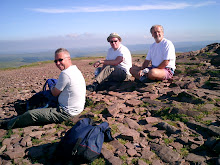


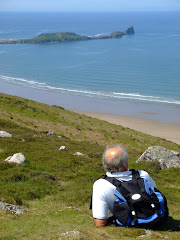


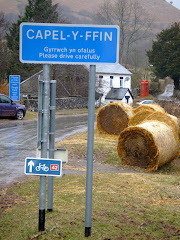
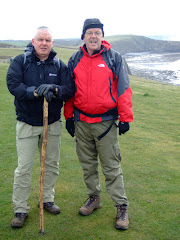


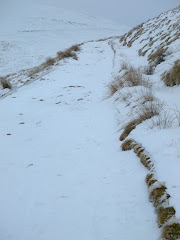


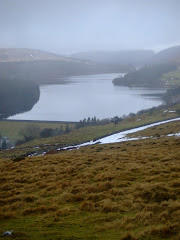














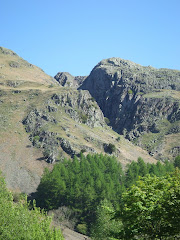

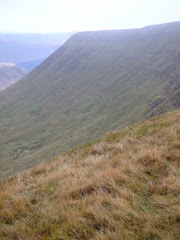

tip top
ReplyDeleteFantastic day spent in great company.
ReplyDeleteBurnt face,closed final stack,sore feet, chose wrong meal...what a great day!!
ReplyDelete